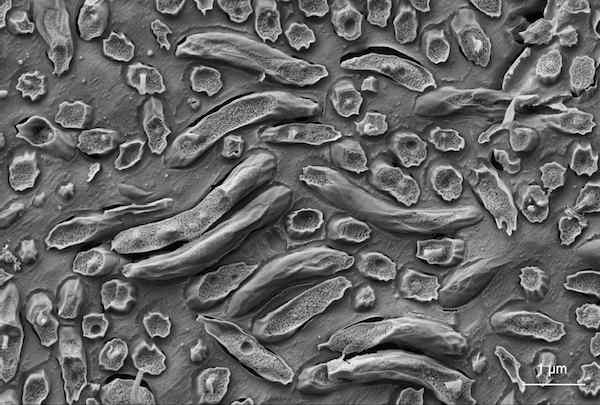
[Image above] Credit: SEM of high-pressure frozen, freeze-fractured Magnetospirillum spec. Credit: Zeiss Microscopy; Flickr CC BY-NC-ND 2.0

Artificial magnetic bacteria are probiotic bacteria surrounded by thousands of magnetic iron oxide nanoparticles. The bacteria, labelled here with green fluorescent dye, are living magnets that align with an external magnetic field. Credit: University of Granada
Microbes never fail to amaze me.
They colonize pretty much any niche you can imagine, even the ones that are too extreme for most other forms of life to survive. They come in a dizzying array of colors, shapes, properties, and characteristics. And—let’s just say it—some of them are downright weird, weird, weird.
Microbes are also largely responsible for snow and can now be engineered with extra letters—G, A, T, C, X, and Y—in their DNA alphabet. And, in addition to practically every other environment imaginable, microbes colonize our bodies and have recently become appreciated as an integral component of our health and lack thereof.
Strangely enough, some bacteria are even magnetic. Magnetotactic bacteria biomineralize compounds to produce magnetic crystals like magnetite (iron oxide) or greigite (iron sulfide). They come equipped with specialized little organelles, called magnetosomes, expressly for this purpose. Magnetotactic bacteria literally have an internal compass—they can align themselves with the earth’s magnetic field, which is thought to help them navigate.
Those magnetic properties have led scientists to wonder if magnetotactic bacteria could be used for health monitoring purposes and to diagnose and treat disease (e.g., in conjunction with imaging techniques or as a targeted biomarker). However, the cultivation of naturally magnetic bacteria turns out to be a bit tricky, and no one knows what would happen if you put those little bugs in your body. (Who wants to be the guinea pig?)
Because a lot of research has firmly established the positive health benefits of probiotics, or the good bacteria naturally found in the human body, scientists at the University of Granada took a different approach to get safe and scalable magnetic bacteria. The group engineered probiotic bacteria—namely Lactobacillus fermentum and Bifidobacteria breve—to be magnetic, rather than trying to make naturally magnetic bacteria safe and scalable. The work is published in the newest issue of Advanced Functional Materials.
According to a University of Granada press release, “These important findings constitute the first use of a food as a natural drug and aid in diagnosing an illness, anywhere in the world.”
To engineer the bugs, the scientists loaded them up with nanoparticles of maghemite, which is essentially Fe(II)-deficient magnetite. The bacteria easily adsorped the iron oxide onto their external surfaces to a final concentration ranging from 0.1 mg to 25 mg of iron per gram of bacteria.
The particles didn’t kill the bugs, and, according to the paper, the researchers say the bugs could “be guided towards a target when exposed to a directional magnetic field.”
The research was performed in collaboration with biotech company Biosearch and has spawned a patent for the technology and applications, according to the press release.
The authors speculate that artificial magnetic bacteria could be used for a variety of biomedical applications, including magnetic resonance imaging to facilitate diagnosis of diseases, hyperthermia to selectively heat and kill cancer cells, and as biosensors for particular markers, proteins, or cell types. Magnetic bacteria could potentially be labeled to target specific cells or recognize specific proteins, to either sense problems or deliver drugs. Because probiotics have been shown to localize to hypoxic regions of tumors, they could be used to detect cancers through simple ingestion of a yogurt cup followed by a magnetic imaging modality.
The bacteria could also be used in laboratory experiments to separate single cells or cell types for precise experiments. In fact, a new microchip-like technology developed at Duke University could be combined with magnetic bacteria to perform really small-scale and informative studies. The Duke study was published in Nature Communications.
The Duke researchers developed a magnetic chip that works like a random access memory chip. On it, thin printed electromagnetic components create a miniscule magnetic track system on which magnetic beads—or, potentially, magnetic cells—can be moved and analyzed in a one-by-one fashion. The intended purpose of the chip was to be able to track magnetically-labeled cells for single cell analyses.
“You need to analyze thousands of cells to get the statistics necessary to understand which genes are being turned on and off in response to pharmaceuticals or other stimuli,” says senior author and mechanical engineering and materials science professor Benjamin Yellen in a Duke press release. “And if you’re looking for cells exhibiting rare behavior, which might be one cell out of a thousand, then you need arrays that can control hundreds of thousands of cells.”
Watch the video below to see the chip in action.
The papers are “Artificial Magnetic Bacteria: Living Magnets at Room Temperature” (DOI: 10.1002/adfm.201303754) and “Magnetophoretic circuits for digital control of single particles and cells” (DOI: 10.1038/ncomms4846).

Researchers at Duke University have fabricated a tiny magnetic chip that works like a random access memory chip. Credit: Duke Engineering; Youtube
Author
April Gocha
CTT Categories
- Material Innovations
- Nanomaterials
- Weekly Column: “Other materials”

